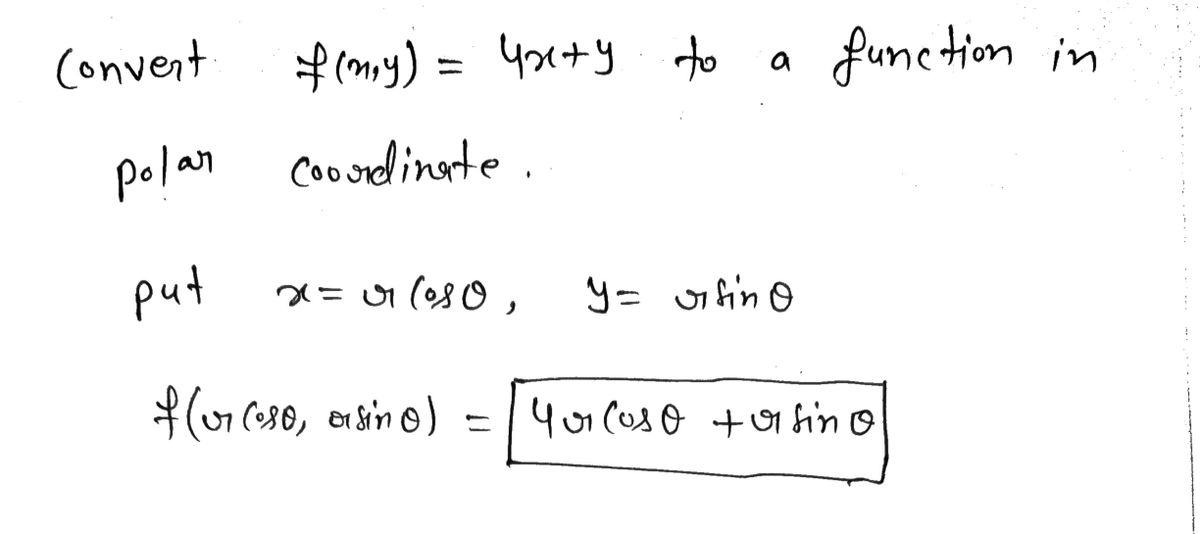Calculus: Early Transcendentals
8th Edition
ISBN:9781285741550
Author:James Stewart
Publisher:James Stewart
Chapter1: Functions And Models
Section: Chapter Questions
Problem 1RCC: (a) What is a function? What are its domain and range? (b) What is the graph of a function? (c) How...
Related questions
Question
The equation is f(x,y)=4x+y
![Convert \( f(x, y) = 4x + y \) to a function in polar coordinates.
\[ f(r, \theta) = 4(r \cos(\theta)) + (r \sin(\theta)) \]](/v2/_next/image?url=https%3A%2F%2Fcontent.bartleby.com%2Fqna-images%2Fquestion%2F09d105f3-6c69-4cbc-8997-6988f1733e6f%2Fcac50d46-a0b4-4b9f-b6b1-6c51c6eaede7%2Fs1se07s_processed.png&w=3840&q=75)
Transcribed Image Text:Convert \( f(x, y) = 4x + y \) to a function in polar coordinates.
\[ f(r, \theta) = 4(r \cos(\theta)) + (r \sin(\theta)) \]
![Let \( R \) be the region in the first quadrant bounded by \( y = \sqrt{1-x^2} \), \( y = \sqrt{25-x^2} \), \( y = 0 \), and \( y = \sqrt{3}x \).
Represent this region in polar coordinates.
\[ 1 \leq r \leq 5 \]
\[ 0 \leq \theta \leq \frac{\pi}{3} \]](/v2/_next/image?url=https%3A%2F%2Fcontent.bartleby.com%2Fqna-images%2Fquestion%2F09d105f3-6c69-4cbc-8997-6988f1733e6f%2Fcac50d46-a0b4-4b9f-b6b1-6c51c6eaede7%2Fvn3nzb9_processed.png&w=3840&q=75)
Transcribed Image Text:Let \( R \) be the region in the first quadrant bounded by \( y = \sqrt{1-x^2} \), \( y = \sqrt{25-x^2} \), \( y = 0 \), and \( y = \sqrt{3}x \).
Represent this region in polar coordinates.
\[ 1 \leq r \leq 5 \]
\[ 0 \leq \theta \leq \frac{\pi}{3} \]
Expert Solution
Step 1

Step by step
Solved in 2 steps with 2 images

Follow-up Questions
Read through expert solutions to related follow-up questions below.
Follow-up Question
With this question, I dont know how to solve for the double

Transcribed Image Text:Thus, \(\iint f(x, y) \, dA = \int_0^{\frac{\pi}{3}} \int_1^5 \boxed{\phantom{f(x, y)}} \, dr \, d\theta\)
![Finally, the value of your double integral is [input box].
(Note: The image contains a text prompt encouraging the user to input the result of their double integral calculation, with a blank input box provided for the answer.)](https://content.bartleby.com/qna-images/question/09d105f3-6c69-4cbc-8997-6988f1733e6f/8e2bfe4d-b99a-451a-bd0a-2fc347221441/d28n16_thumbnail.png)
Transcribed Image Text:Finally, the value of your double integral is [input box].
(Note: The image contains a text prompt encouraging the user to input the result of their double integral calculation, with a blank input box provided for the answer.)
Solution
Recommended textbooks for you

Calculus: Early Transcendentals
Calculus
ISBN:
9781285741550
Author:
James Stewart
Publisher:
Cengage Learning

Thomas' Calculus (14th Edition)
Calculus
ISBN:
9780134438986
Author:
Joel R. Hass, Christopher E. Heil, Maurice D. Weir
Publisher:
PEARSON

Calculus: Early Transcendentals (3rd Edition)
Calculus
ISBN:
9780134763644
Author:
William L. Briggs, Lyle Cochran, Bernard Gillett, Eric Schulz
Publisher:
PEARSON

Calculus: Early Transcendentals
Calculus
ISBN:
9781285741550
Author:
James Stewart
Publisher:
Cengage Learning

Thomas' Calculus (14th Edition)
Calculus
ISBN:
9780134438986
Author:
Joel R. Hass, Christopher E. Heil, Maurice D. Weir
Publisher:
PEARSON

Calculus: Early Transcendentals (3rd Edition)
Calculus
ISBN:
9780134763644
Author:
William L. Briggs, Lyle Cochran, Bernard Gillett, Eric Schulz
Publisher:
PEARSON

Calculus: Early Transcendentals
Calculus
ISBN:
9781319050740
Author:
Jon Rogawski, Colin Adams, Robert Franzosa
Publisher:
W. H. Freeman


Calculus: Early Transcendental Functions
Calculus
ISBN:
9781337552516
Author:
Ron Larson, Bruce H. Edwards
Publisher:
Cengage Learning